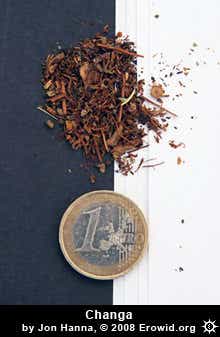Changa
This article is a stub. As such, it may contain incomplete or wrong information. You can help by expanding it. |
Changa (or xanga) is a blanket term for a smokable blend that contains the psychedelic substance dimethyltryptamine (NN-DMT) infused onto a MAOI containing herb such as syrian rue or banisteriopsis caapi.
Changa is usually made by pouring a DMT solution (such as DMT that has been mixed with isopropyl alcohol) over a chosen blend of herbs and letting the solvent evaporate. The final product can then be smoked in a manner like tobacco or cannabis. Although there are many varieties of Changa, like ayahuasca, the key active ingredients are DMT and an MAOI. The inclusion of the MAOI is reported to extend the experience by 10 to 30 minutes while making it more subjectively coherent and less chaotic than freebase DMT.
An alternate way experience Changa is to orally dose a MAOI agent (either pharmaceutical or herbal) and then proceed to vaporize DMT as one normally would after the MAOI has taken effect. This has the advantage of allowing the user to "break through" on significantly lower dose.
The percentages of DMT and MAOI concentration in the mixture can vary. A typical mixture would be characterized by breakthrough experiences at a dosage of approximately "one full bong bowl" (with each breath held in for at least 20 full seconds). There have also been reports of breakthroughs occurring with Changa that has been rolled into joints, though this is a far less reliable method of doing do.
The main advantage of smoking Changa directly over smoking pure free-base DMT is that it's easier to smoke and reduces the chance of burning the DMT instead of vaping it. A guide to properly preparing Changa can be accessed here.
History
Changa was created by Australian Julian Palmer in 2003-2004[1] nd named when he 'asked' for a moniker for the drug during an Ayahuasca session.[2]
Changa was growing in popularity as of 2015 due to its ease of smoking and longer duration (approximately 10-20 minutes) compared to smoking freebase DMT crystal.[3]
Enhanced leaf
"Enhanced leaf" is a related term that is sometimes used to describe DMT-containing herb-mixtures that do not contain MAOIs. Common herbs that can be used for this purpose can range from passionflower to mint leaves.
Toxicity and harm potential
 |
This toxicity and harm potential section is a stub. As a result, it may contain incomplete or even dangerously wrong information! You can help by expanding upon or correcting it. |
Dangerous interactions
Warning: Many psychoactive substances that are reasonably safe to use on their own can suddenly become dangerous and even life-threatening when combined with certain other substances. The following list provides some known dangerous interactions (although it is not guaranteed to include all of them).
Always conduct independent research (e.g. Google, DuckDuckGo, PubMed) to ensure that a combination of two or more substances is safe to consume. Some of the listed interactions have been sourced from TripSit.
- Stimulants - The neurotoxic effects of drugs like MDMA may be increased when combined with a changa mixture.
- 25x-NBOMe - Both the NBOMe series and this compound induce powerful stimulation and their interaction may cause severe side effects. These can include thought loops, seizures, increased blood pressure, vasoconstriction, increased heart rate, and heart failure (in extreme cases).
- DXM - This combination may cause increased heart rate and panic attacks.
- MXE - Increased heart rate and blood pressure may occur.
- Tramadol - This combination can increase the risk of seizures.
Serotonin syndrome risk
Combinations with the following substances can cause dangerously high serotonin levels. Serotonin syndrome requires immediate medical attention and can be fatal if left untreated.
- MAOIs - Such as banisteriopsis caapi, syrian rue, phenelzine, selegiline, and moclobemide.[4]
- Serotonin releasers - Such as MDMA, 4-FA, methamphetamine, methylone and αMT.
- SSRIs - Such as citalopram and sertraline
- SNRIs - Such as tramadol and venlafaxine
- 5-HTP
There is an increased risk of serotonin syndrome when changa (or more specifically, the MAOI component of it) is taken with many antidepressants, particularly selective serotonin reuptake inhibitors (SSRIs) and serotonin-norepinephrine reuptake inhibitors (SNRIs).
External links
References
- ↑ St. John, G. (2016). Labate, B. C., ed. Aussiewaska: A Cultural History of Changa and Ayahuasca Analogues in Australia. Vitality of indigenous religions. The world Ayahuasca diaspora: reinventions and controversies. Routledge, Taylor & Francis Group. ISBN 9781472466631.
- ↑ Berger, M. (2015). Changa die rauchbare Evolution des Ayahuasca. ISBN 9783037883563.
- ↑ Lyden, J., Mazur, E. M. (2015). The Routledge companion to religion and popular culture. ISBN 9780415638661.
- ↑ Gillman, P. K. (2005). "Monoamine oxidase inhibitors, opioid analgesics and serotonin toxicity". British Journal of Anaesthesia. 95 (4): 434–441. doi:10.1093/bja/aei210
 . eISSN 1471-6771. ISSN 0007-0912. OCLC 01537271. PMID 16051647.
. eISSN 1471-6771. ISSN 0007-0912. OCLC 01537271. PMID 16051647.
